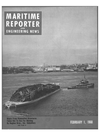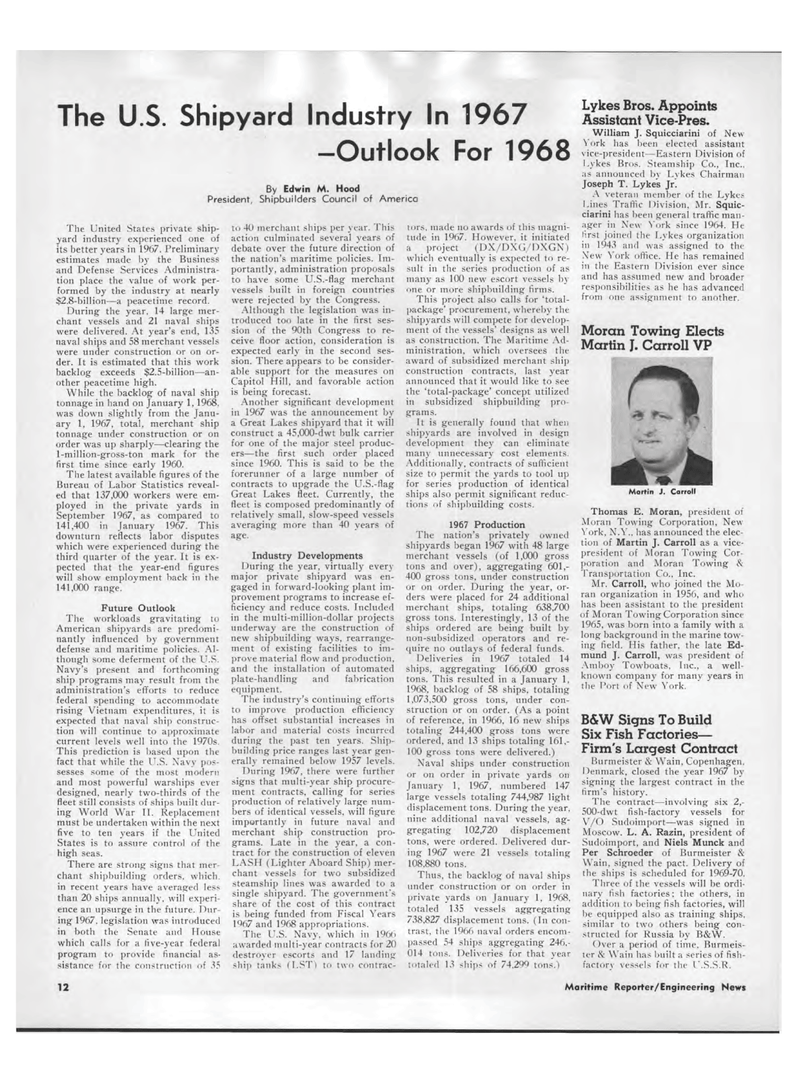
Page 10: of Maritime Reporter Magazine (February 1968)
Read this page in Pdf, Flash or Html5 edition of February 1968 Maritime Reporter Magazine
The U.S. Shipyard Industry In 1967 -Outlook For 1968 By Edwin M. Hood President, Shipbuilders Council of America The United States private ship-yard industry experienced one of its better years in 1967. Preliminary estimates made by the Business and Defense Services Administra-tion place the value of work per-formed by the industry at nearly $2.8-billion?a peacetime record. During the year, 14 large mer-chant vessels and 21 naval ships were delivered. At year's end, 135 naval ships and 58 merchant vessels were under construction or on or-der. It is estimated that this work backlog exceeds $2.5-billion?an-other peacetime high. While the backlog of naval ship tonnage in hand on January 1, 1968, was down slightly from the Janu-ary 1, 1967, total, merchant ship tonnage under construction or on order was up sharply?clearing the 1-million-gross-ton mark for the first time since early 1960. The latest available figures of the Bureau of Labor Statistics reveal-ed that 137,000 workers were em-ployed in the private yards in September 1967, as compared to 141,400 in January 1967. This downturn reflects labor disputes which were experienced during the third quarter of the year. It is ex-pected that the year-end figures will show employment back in the 141,000 range. Future Outlook The workloads gravitating to American shipyards are predomi-nantly influenced by government defense and maritime policies. Al-though some deferment of the U.S. Navy's present and forthcoming ship programs may result from the administration's efforts to reduce federal spending to accommodate rising Vietnam expenditures, it is expected that naval ship construc-tion will continue to approximate current levels well into the 1970s. This prediction is based upon the fact that while the U.S. Navy pos-sesses some of the most modern and most powerful warships ever designed, nearly two-thirds of the fleet still consists of ships built dur-ing World War II. Replacement must be undertaken within the next five to ten years if the United States is to assure control of the high seas. There are strong signs that mer-chant shipbuilding orders, which, in recent years have averaged less than 20 ships annually, will experi-ence an upsurge in the future. Dur-ing 1967, legislation was introduced in both the Senate and House which calls for a five-year federal program to provide financial as-sistance for the construction of 35 to 40 merchant ships per year. This action culminated several years of debate over the future direction of the nation's maritime policies. Im-portantly, administration proposals to have some U.S.-flag merchant vessels built in foreign countries were rejected by the Congress. Although the legislation was in-troduced too late in the first ses-sion of the 90th Congress to re-ceive floor action, consideration is expected early in the second ses-sion. There appears to be consider-able support for the measures on Capitol Hill, and favorable action is being forecast. Another significant development in 1967 was the announcement by a Great Lakes shipyard that it will construct a 45,000-dwt bulk carrier for one of the major steel produc-ers?the first such order placed since 1960. This is said to be the forerunner of a large number of contracts to upgrade the U.S.-flag Great Lakes fleet. Currently, the fleet is composed predominantly of relatively small, slow-speed vessels averaging more than 40 years of age. Industry Developments During the year, virtually every major private shipyard was en-gaged in forward-looking plant im-provement programs to increase ef-ficiency and reduce costs. Included in the multi-million-dollar projects underway are the construction of new shipbuilding ways, rearrange-ment of existing facilities to im-prove material flow and production, and the installation of automated plate-handling and fabrication equipment. The industry's continuing efforts to improve production efficiency has offset substantial increases in labor and material costs incurred during the past ten years. Ship-building price ranges last year gen-erally remained below 1957 levels. During 1967, there were further signs that multi-year ship procure-ment contracts, calling for series production of relatively large num-bers of identical vessels, will figure importantly in future naval and merchant ship construction pro-grams. Late in the year, a con-tract for the construction of eleven LASH (Lighter Aboard Ship) mer-chant vessels for two subsidized steamship lines was awarded to a single shipyard. The government's share of the cost of this contract is being funded from Fiscal Years 1967 and 1968 appropriations. The U.S. Navy, which in 1966 awarded multi-year contracts for 20 destroyer escorts and 17 landing ship tanks (LST) to two contrac-tors. made no awards of this magni-tude in 1967. However, it initiated a project (DX/DXG/DXGN) which eventually is expected to re-sult in the series production of as many as 100 new escort vessels by one or more shipbuilding firms. This project also calls for 'total-package' procurement, whereby the shipyards will compete for develop-ment of the vessels' designs as well as construction. The Maritime Ad-ministration, which oversees the award of subsidized merchant ship construction contracts, last year announced that it would like to see the 'total-package' concept utilized in subsidized shipbuilding pro-grams. It is generally found that when shipyards are involved in design development they can eliminate many unnecessary cost elements. Additionally, contracts of sufficient size to permit the yards to tool up for series production of identical ships also permit significant reduc-tions of shipbuilding costs. 1967 Production The nation's privately owned shipyards began 1967 with 48 large merchant vessels (of 1,000 gross tons and over), aggregating 601,-400 gross tons, under construction or on order. During the year, or-ders were placed for 24 additional merchant ships, totaling 638,700 gross tons. Interestingly, 13 of the ships ordered are being built by non-subsidized operators and re-quire no outlays of federal funds. Deliveries in 1967 totaled 14 ships, aggregating 166,600 gross tons. This resulted in a January 1, 1968, backlog of 58 ships, totaling 1,073,500 gross tons, under con-struction or on order. (As a point of reference, in 1966, 16 new ships totaling 244,400 gross tons were ordered, and 13 ships totaling 161.-100 gross tons were delivered.) Naval ships under construction or on order in private yards on January 1, 1967, numbered 147 large vessels totaling 744,987 light displacement tons. During the year, nine additional naval vessels, ag-gregating 102,720 displacement tons, were ordered. Delivered dur-ing 1967 were 21 vessels totaling 108,880 tons. Thus, the backlog of naval ships under construction or on order in private yards on January 1, 1968, totaled 135 vessels aggregating 738,827 displacement tons. (In con-trast, the 1966 naval orders encom-passed 54 ships aggregating 246.-014 tons. Deliveries for that year totaled 13 ships of 74.299 tons.) Lykes Bros. Appoints Assistant Vice-Pres. William J. Squicciarini of New York has been elected assistant vice-president?Eastern Division of Lykes Bros. Steamship Co., Inc., as announced by Lykes Chairman Joseph T. Lykes Jr. A veteran member of the Lykes Lines Traffic Division, Mr. Squic-ciarini has been general traffic man-ager in New York since 1964. He first joined the Lykes organization in 1943 and was assigned to the New York office. He has remained in the Eastern Division ever since and has assumed new and broader responsibilities as he has advanced from one assignment to another. Moran Towing Elects Martin J. Carroll VP Martin J. Carroll Thomas E. Moran, president of Moran Towing Corporation, New York, N.Y., has announced the elec-tion of Martin J. Carroll as a vice-president of Moran Towing Cor-poration and Moran Towing & Transportation Co., Inc. Mr. Carroll, who joined the Mo-ran organization in 1956, and who has been assistant to the president of Moran Towing Corporation since 1965, was born into a family with a long background in the marine tow-ing field. His father, the late Ed-mund J. Carroll, was president of Amboy Towboats, Inc., a well-known company for many years in the Port of New York. B&W Signs To Build Six Fish Factories? Firm's Largest Contract Burmeister & Wain, Copenhagen, Denmark, closed the year 1967 by signing the largest contract in the firm's history. The contract?involving six 2,-500-dwt fish-factory vessels for V/O Sudoimport?was signed in Moscow. L. A. Razin, president of Sudoimport, and Niels Munck and Per Schroeder of Burmeister & Wain, signed the pact. Delivery of the ships is scheduled for 1969-70. Three of the vessels will be ordi-nary fish factories; the others, in addition to being fish factories, will be equipped also as training ships, similar to two others being con-structed for Russia by B&W. Over a period of time, Burmeis-ter & Wain has built a series of fish-factory vessels for the U.S.S.R. 12 Maritime Reporter/Engineering News

 9
9

 11
11
